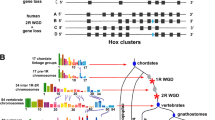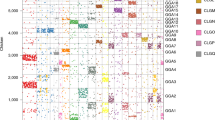Abstract
Applying the parsimony principle, i.e. that chromosomes identical in species belonging to different taxa were likely to be present in their common ancestor, the ancestral karyotype of eutherian mammals (about 100 million years old) was tentatively reconstructed. Comparing chromosome banding with all ZOO-FISH data from literature or studied by us, this reconstruction can be proposed with only limited uncertainties. This karyotype comprised 50 chromosomes of which 40–42 were acrocentrics. Ten ancestral pairs of chromosomes were homologous to a single human chromosome: 5, 6, 9, 11, 13, 17, 18, 20, X and Y (human nomenclature). Nine others were homologous to a part of a human chromosome: 1p+q (proximal), 1q, 2p+q (proximal), 2q, part of 7, 8q, 10p, 10q and 19p (human nomenclature). Finally, seven pairs of chromosomes, homologs to human chromosomes 3 + 21, 4 + 8p, part of 7 + 16p, part of 12 + part of 22 (twice), 14+15, 16q+19q, formed syntenies disrupted in man.
Similar content being viewed by others
References
Bailey JA, Yavor AM, Massa HF, Trask BJ, Eichler EE (2001) Segmental duplications: organization and impact within the current human genome project assembly. Genome Res 11: 1005–1017.
Best RG, Diamond D, Crawford E et al. (1998) Baboon/human homologies examined by spectral karyotyping (SKY): a visual comparison. Cytogenet Cell Genet 82: 83–87.
Bielec PE, Gallagher DS, Womack JE, Busbee DL (1998) Homologies between human and dolphin chromosomes detected by heterologous chromosome painting. Cytogenet Cell Genet 81: 18–25.
Buckland RA, Evans HJ (1978) Cytogenetic aspects of phylogeny in the Bovidae. I. G-banding. Cytogenet Cell Genet 21: 42–63.
Burkin DJ, Yang F, Broad TE et al. (1997) Use oft he Indian muntjac idiogram to align conserved chromosomal segments in sheep and human genomes by chromosome painting. Genomics 46: 143–147.
Chowdhary BP, Raudsepp T, Fronicke L, Scherthan H (1998) Emerging patterns ofc omparative genome organization in some mammalian species as revealed by Zoo-FISH. Genome Res 8: 577–589.
Couturier J, Dutrillaux B (1986) Evolution chromosomique chez les Carnivores. Mammalia 50 (special issue): 124–162.
Di Berardino D, Hayes H, Fries R, Long S (1990) International system for cytogenetic nomenclature of domestic animals. ISCNDA (1989). Cytogenet Cell Genet 53: 65–79.
Dixkens C, Klett C, Bruch J et al. (1998) ZOO-FISH analysis in insectivores: “Evolution extols the virtue oft he status quo”. Cytogenet Cell Genet 80: 61–67.
Dutrillaux B (1979a) Chromosomal evolution in primates: tentative phylogeny from Microcebus murinus (Prosimian) to man. Hum Genet 48: 251–314.
Dutrillaux B (1979b) Very large analogy ofc hromosome banding between Cebus capucinus (Platyrrhini) and man. Cytogenet Cell Genet 24: 84–94.
Dutrillaux B, Couturier J (1981) La Pratique de l'Analyse Chromosomique Paris: Masson.
Dutrillaux B, Couturier J (1983) The ancestral karyotype of Carnivora: comparison with that ofpl atyrrhine monkeys. Cytogenet Cell Genet 35: 200–208.
Dutrillaux B, Rethore MO, Lejeune J (1975) [Comparison of the karyotype oft he orangutan (Pongo pygmaeus) to those ofm an, chimpazee, and gorilla]. Ann Genet 18: 153–161.
Dutrillaux B, Viegas-Pequignot E, Couturier J et al. (1980) [Great homology ofc hromosome banding oft he rabbit (Oryctolagus cuniculus) and primates, including man (author's transl)]. Ann Genet 23: 22–25.
Dutrillaux B, Couturier J, Viegas-Pequignot E (1981) Chromosomal evolution in primates. In: Chromosomes Today. London: George Allen & Unwin, pp. 176–191.
Dutrillaux B, Couturier J, Viegas-Pequignot E, Muleris M (1982) Cytogenetic aspects ofpr imate evolution. In: Human Genetics. New York: Alan R. Liss, pp 183–194.
Dutrillaux B, Couturier J, Viegas-Pequignot E (1986) Evolution chromosomique des Platyrhiniens. Mammalia 50 (special issue): 56–81.
Fronicke L, Muller-Navia J, Romanakis K, Scherthan H(1997) Chromosomal homeologies between human, harbor seal (Phoca vitulina) and the putative ancestral carnivore karyotype revealed by Zoo-FISH. Chromosoma 106: 108–113.
Gustavsson I, Hageltorn M, Iannuzzi L et al. (1976) Staining technique for definite identification of individual cattle chromosomes in routine analysis. J Hered 67: 175–178.
Haig D (1999) A briefhi story of human autosomes. Phil Trans R Soc Lond B 354: 1447–1470.
Hameister H, Klett C, Bruch J et al. (1997) Zoo-FISH analysis: the American mink (Mustela vison) closely resembles the cat karyotype. Chromosome Res 5: 5–11.
Hayes H (1995) Chromosome painting with human chromosome-specific DNA libraries reveals the extent and distribution ofc onserved segments in bovine chromosomes. Cytogenet Cell Genet 71: 168–174.
Iannuzzi L, Di Meo GP, Perucatti A, Ferrara L (1990) The high resolution G-and R-banding pattern in chromosomes of river buffalo (Bubalus bubalis L.). Hereditas 112: 209–215.
Iannuzzi L, Di Meo GP, Perucatti A, Bardaro T (1998) ZOO-FISH and R-banding reveal extensive conservation ofhu man chromosome regions in euchromatic regions of river buffalo chromosomes. Cytogenet Cell Genet 82: 210–214.
Jauch A, Wienberg J, Stanyon R et al. (1992) Reconstruction of genomic rearrangements in great apes and gibbons by chromosome painting. Proc Natl Acad Sci USA 89: 8611–8615.
Korstanje R, O'Brien PC, Yang F et al. (1999) Complete homology maps oft he rabbit (Oryctolagus cuniculus) and human by reciprocal chromosome painting. Cytogenet Cell Genet 86: 317–322.
Maccarone P, Watson JM, Francis D et al. (1992) The evolution ofhu man chromosome 21: evidence from in situ hybridization in marsupials and a monotreme. Genomics 13: 1119–1124.
Matthey R (1973) The chromosome formulae of eutherian mammals. In: Chiarelli A, Capanna E. eds. Cytotaxonomy and Vertebrate Evolution, Academic Press, London: pp 531–616.
Muller S, O'Brien PC, Ferguson-Smith MA, Wienberg J (1997) Reciprocal chromosome painting between human and prosimians (Eulemur macaco macaco and E. fulvus mayottensis). Cytogenet Cell Genet 78: 260–271.
Muller S, Stanyon R, O'Brien PC et al. (1999) Defining the ancestral karyotype ofa ll primates by multidirectional chromosome painting between tree shrews, lemurs and humans. Chromosoma 108: 393–400.
Muller S, Stanyon R, Finelli P, Archidiacono N, Wienberg J (2000) Molecular cytogenetic dissection ofh uman chromosomes 3 and 21 evolution. Proc Natl Acad Sci USA 97: 206–211.
Mural RJ, Adams MD, Myers EW et al. (2002) A comparison ofwh ole-genome shotgun-derived mouse chromosome 16 and the human genome. Science 296: 1661–1671.
Murphy WJ, Sun S, Chen Z et al. (2000) A radiation hybrid map oft he cat genome: implications for comparative mapping. Genome Res 10: 691–702.
Murphy WJ, Eizirik E, Johnson WE et al. (2001a) Molecular phylogenetics and the origins ofpl acental mammals. Nature 409: 614–618.
Murphy WJ, Stanyon R, O'Brien SJ (2001b) Evolution of mammalian genome organization inferred from comparative gene mapping. Genome Biol 2: reviews0005.
O'Brien SJ, Graves JA (1991) Report oft he committee on comparative gene mapping. Cytogenet Cell Genet 58: 1124–1151.
Ohno S, Beçak W, Beçak ML (1964) X-autosome ratio and the behavior pattern ofi ndividual X-chromosomes in placental mammals. Chromosoma 15: 14–30.
Petit D, Couturier J, Viegas-Pequignot E, Lombard M, Dutrillaux B (1984) [Great degree ofh omology between the ancestral karyotype of squirrels (rodents) and that of primates and carnivores]. Ann Genet 27: 201–212.
Raudsepp T, Fronicke L, Scherthan H, Gustavsson I, Chowdhary BP (1996) Zoo-FISH delineates conserved chromosomal segments in horse and man. Chromosome Res 4: 218–225.
Rettenberger G, Klett C, Zechner U et al. (1995) Visualization oft he conservation of synteny between humans and pigs by heterologous chromosomal painting. Genomics 26: 372–378.
Richard F, Dutrillaux B (1998) Origin ofh uman chromosome 21 and its consequences: a 50-million-year-old story. Chromosome Res 6: 263–268.
Richard F, Lombard M, Dutrillaux B (1996) ZOO-FISH suggests a complete homology between human and capuchin monkey (Platyrrhini) euchromatin. Genomics 36: 417–423.
Richard F, Lombard M, Dutrillaux B (2000) Phylogenetic origin ofhu man chromosomes 7, 16, and 19 and their homologs in placental mammals. Genome Res 10: 644–651.
Richard F, Messaoudi C, Lombard M, Dutrillaux B (2001) Chromosome homologies between man and mountain zebra (Equus zebra hartmannae) and description of a new ancestral synteny involving sequences homologous to human chromosomes 4 and 8. Cytogenet Cell Genet 93: 291–296.
Romagnano A, Richer CL (1985) High resolution R-bands produced in equine chromosomes after incorporation of bromodeoxyuridine. J Hered 76: 377–378.
Ronne M, Iannuzzi L, Di Meo GP, Perucatti A, Ferrara L (1995) Localization of landmarks and bands in the karotype of Sus scrofa domestica. Comparison between different classifications. Hereditas 123: 155–168.
Roubin M, de Grouchy J, Klein LM(1973) [The felidae: chromosomal evolution]. Ann Genet 16: 233–245.
Rumpler Y, Dutrillaux B (1976) Chromosomal evolution in Malagasy lemurs. I. Chromosome banding studies in the genuses Lemur and Microcebus. Cytogenet Cell Genet 17: 268–281.
Rumpler Y, Dutrillaux B (1990) Cell Biology Reviews. Chromosomal Evolution and Speciation in Primates. Leioa-Vizcaya: Springer International, pp 1–116.
Toder R, von Holst D, Schempp W (1992) Comparative cytogenetic studies in tree shrews (Tupaia). Cytogenet Cell Genet 60: 55–59.
Trask BJ, Massa H, Brand-Arpon V et al. (1998) Large multi-chromosomal duplications encompass many members of the olfactory receptor gene family in the human genome. Hum Mol Genet 7: 2007–2020.
Viale A, Ortola C, Richard F et al. (1998) Emergence ofa brain-expressed variant melanin-concentrating hormone gene during higher primate evolution: a gene 'in search of a function'. Mol Biol Evol 15: 196–214.
Volleth M, Klett C, Kollak A et al. (1999) ZOO-FISH analysis in a species oft he order Chiroptera: Glossophaga soricina (Phyllostomidae). Chromosome Res 7: 57–64.
Volobouev VT (1989) Phylogenetic relationships oft he Sorex araneus-arcticus species complex (Insectivora, Soricidae) based on high-resolution chromosome analysis. J Hered 80: 284–290.
Wienberg J, Stanyon R, Jauch A, Cremer T (1992) Homologies in human and Macaca fuscata chromosomes revealed by in situ suppression hybridization with human chromosome specific DNA libraries. Chromosoma 101: 265–270.
Wienberg J, Stanyon R, Nash WG et al. (1997) Conservation of human vs. feline genome organization revealed by reciprocal chromosome painting. Cytogenet Cell Genet 77: 211–217.
Yang F, Muller S, Just R, Ferguson-Smith MA, Wienberg J (1997) Comparative chromosome painting in mammals: human and the Indian muntjac (Muntiacus muntjak vaginalis). Genomics 39: 396–401.
Yang F, Alkalaeva EZ, Perelman PL et al. (2003) Reciprocal chromosome painting among human, aardvark and elephant (superorder Afrotheria) reveals the likely eutherian ancestral karyotype. Proc Natl Acad Sci USA 100: 1062–1066
Author information
Authors and Affiliations
Rights and permissions
About this article
Cite this article
Richard, F., Lombard, M. & Dutrillaux, B. Reconstruction of the ancestral karyotype of eutherian mammals. Chromosome Res 11, 605–618 (2003). https://doi.org/10.1023/A:1024957002755
Issue Date:
DOI: https://doi.org/10.1023/A:1024957002755




